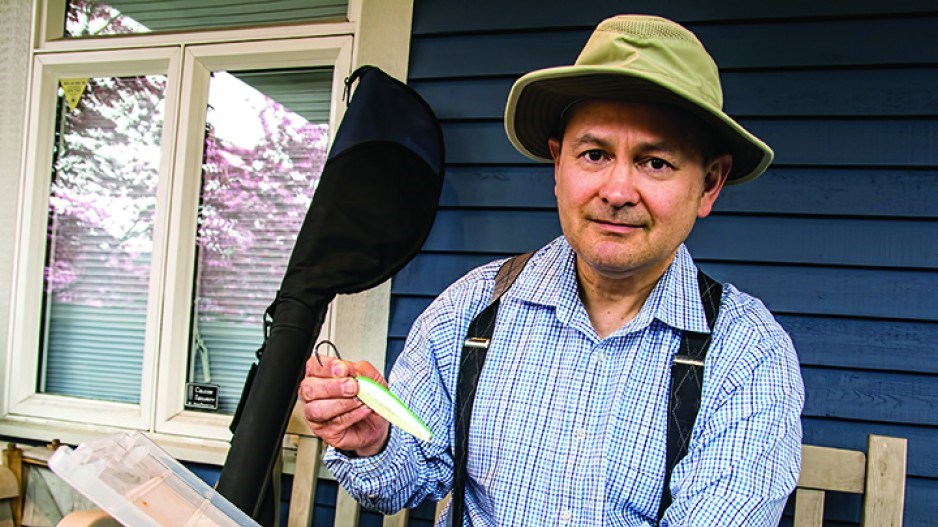The federal government’s restrictions on chinook salmon for recreational fishing this year are not grounded in scientific evidence and will do little to stop the decline of chinook stocks, says a University of British Columbia (UBC) fisheries scientist.
Murdoch McAllister may have a bit of a conflict of interest: he’s a sport fisherman.
But he’s also an associate professor of fisheries assessment and statistics at UBC’s Institute for the Oceans and Fisheries specializing in marine ecosystem modelling and fish stock assessment.
He is taking the Department of Fisheries and Oceans (DFO) to task for implementing chinook non-retention restrictions this year in Georgia Strait, as it did last year, calling it “inappropriately precautionary.”
In a letter to Fisheries and Oceans Minister Bernadette Jordan, McAllister warns that continuing a ban on retention of chinook this year will put pressure on lingcod and other species and will do little to stop the decline of chinook, because predation from seals and sea lions appears to be one of the leading causes of the decline – at least in terms of factors that are within the DFO’s control.
The DFO implemented restrictions last year aimed at halting a decline in the populations of chinook and the southern resident killer whales that eat them. They allowed anglers to catch but not keep chinook caught in the Georgia Strait and other areas.
“Credible, peer-reviewed scientific evidence suggests that DFO is making … a decision that is not justified by scientific evidence,” McAllister writes in his letter to Jordan.
McAllister cited several peer-reviewed studies that point to seals and sea lions preying on chinook as a major contributor to the chinook population’s decline.
One study concluded that the sport fishery accounted for less than 10% of chinook mortality in Georgia Strait between April and July.
Another study he cited concludes that “the maximum sustainable yield for chinook salmon stocks in the Salish Sea has decreased on average by about 73% since the 1970s in association with increased predation from harbour seals.”
Another study of the diet of Georgia Strait harbour seals concluded that 32% to 45% of chinook smolts entering the Strait of Georgia have been eaten by harbour seals in recent years.
A study by retired DFO biologist Peter Olesiuk found that, on average, 2% of Stellar sea lions’ diet in B.C. is made up of chinook.
“It’s not just salmon that the sea lions eat,” McAllister told Business in Vancouver. “They eat herring. There are studies at UBC that currently are finding the reason why a lot of herring populations in B.C. are really low and not recovering is because of predation from sea lions.”
The seal and sea lion population has grown substantially in B.C. since seal hunting was banned in the 1970s. Historically, their populations were controlled by First Nations.
“The abundances are much higher than pre-contact times because there was a lot of First Nations hunting of seals – especially seals – and to some extent sea lions,” McAllister said.
Carl Walters, a retired DFO fisheries scientist, co-authored a paper in the Canadian Journal of Fisheries and Aquatic Sciences in 2018 that found “significant negative correlations between seal densities and productivity of chinook.”
The study concluded that “changes in numbers of seals since the 1970s were associated with a 74% decrease … in maximum sustainable yield in chinook stocks.”
In his letter to Jordan, McAllister recommends that recreational fishermen be allowed to retain chinook that come from hatcheries.
That would require all hatchery chinook to have clipped adipose fins so they can be distinguished from non-hatchery fish. This is already done with coho, he said.
“To increase the chances of making this type of selective fishery fully successful, it would be appropriate for DFO to consider implementing adipose fin clipping of all hatchery-produced chinook salmon,” McAllister wrote.
In the absence of any federal culling programs to control seal and sea lion populations, coastal First Nations have recently decided to take things into their own hands.
Tom Sewid of Pacific Balance Marine Management has issued a call to fellow coastal First Nations to increase the harvesting of sea lions and seals, something they traditionally did, both for food and to manage the populations.
A number of First Nations have responded by hunting sea lions. But Sewid said there is a limited appetite for seal meat among Coastal First Nations.
He is therefore urging First Nations leaders and band councils to apply for commercial harvesting licences from the DFO so that they can sell the meat and hides.




